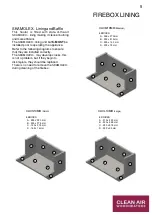
Few things affect the performance of your heater as much as the fuel you burn. Take note of the following:
What Not To Burn
*
Softwood (except kindling)
*
Wet or unseasoned wood
*
Treated or painted timber
*
Saltwater wood
*
Coal or charcoal
*
Garbage, plastic etc
*
Any solvents, kerosene, petrol or any
flammable liquid.
What To Burn
Quite simply, dry seasoned hardwood.
From when wood is first cut down, it takes up to
12 months of dry storage for the wood to
season properly. The seasoning process is
underway when cracks begin to appear at the
ends of cut timber.
Use of moist or unseasoned wood will result in
excessive smoke, longer startup times, a lazy
flame that requires more air to stay alight,
creosote build up in the flue and on the door
glass, and a much less powerful fire. The
reason is simple. Heat that would normally be
going into the room is wasted boiling water that
is trapped inside the wood. This poor
performance costs you money in wasted fuel
and increased maintenance.
It is difficult to determine if wood is dry just by
looking at it. If you can hear the wood sizzle
and hiss, or can see moisture bubbling from
the wood surface, then your wood is too wet. In
practice, the best thing you can do is to be sure
of the source. Buy your wood from reputable
wood merchants. Make sure you store the
wood correctly.
Wood Storage
It is important that wood be stored under cover.
Even wood that is years old will absorb large
quantities of moisture if exposed to the
elements.
It is advisable that wood is stacked to allow
some air flow in and around the logs. This will
help keep the wood dry.
Wood Splitting
It is best to have on hand a good range of wood
sizes to help control the fire. The rule of thumb
is: the hotter the fire, the bigger the log you can
put in.
*
You need very small pieces of kindling to
get the fire started efficiently.
*
Small pieces up to about 50mm thick are
good when the fire is still being established,
or when you want to revive a fire that has
burnt low.
*
Larger logs are excellent for long burns
once the fire is well established.
WOOD SELECTION
8
Summary of Contents for CACL19MB
Page 9: ......

































